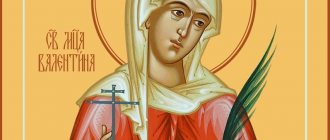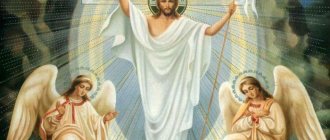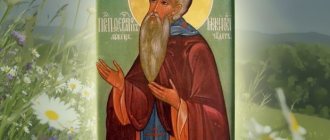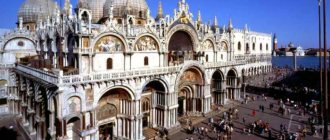Who is the Apostle Barnabas? We find this name in the New Testament, in Acts. He is a constant companion of the Apostle Paul, travels with him and preaches the faith of Christ. But there is not a word about him in the Gospels. Where did Barnabas come from? How did you become an apostle? Has he ever seen the Son of God? When did you start following Him? We will find out this in this article. Let us study the biography (life), deeds and suffering for the faith (martyrdom) of this saint.
Apostle of the Seventy
All four canonical Gospels mention that Jesus chose twelve disciples for himself. The number 12 is so magical that when Judas Iscariot betrayed Christ, the remaining eleven apostles elevated Matthew to their rank to complete the number (Acts 1:26). But among these twelve there was no Barnabas. To understand how he became numbered among the apostles, you need to read chapter ten of the Gospel of Luke. In it the Lord says: “The harvest is plentiful, but the workers in the field are few.” After this, He chose from a large number of His followers seventy men, whom He sent two by two to “every place and every city where He Himself intended to go.” They were supposed to preach the coming of the Messiah to the inhabitants of those places. These disciples are called “the apostles of the seventy.” Among them is the Apostle Barnabas. The election of seventy disciples occurred in the last year of Christ's activity on earth. The Lord gave them the same commandments as he gave to the twelve apostles during the Sermon on the Mount. But because they were not chosen immediately, many of them failed to fully understand and accept the teachings of Christ. The sixth chapter of the Gospel of John tells about this. When Christ said in Capernaum that He is the living bread that came down from heaven, and that whoever eats it will never die, many of the seventy “went away from Him and followed him no more.”
Icons and frescoes of the monastery
Today the monastery houses an interesting museum of icons and archeology. One of the surviving frescoes from the 12th century is called “Pantocrator” - Christ Pantocrator. It is believed that it was made by a Byzantine master who painted the Church of Asizu in Sicily.
Other frescoes depict the following scenes: how Archbishop Anthimus opens the crypt, and then transfers the discovered Gospel to the Byzantine emperor; how Zeno presents imperial gifts to the archbishop for a valuable find. Most of the 15th century paintings were made in the Franco-Byzantine style.
The icons in the monastery date back to the 18th–19th centuries; their authors are the monks living here. Therefore, various scenes related to the construction of the monastery are depicted here.
The historical museum of the monastery displays archaeological finds: antique ceramics, Roman glassware and ancient jewelry. It will be interesting to visit a carpet workshop with products by local authors.
© rolf frische luft
Disciple, firm in faith
Was the apostle Barnabas among these apostates? As we see from the further description of the life of the Church, no. He had a sharp mind and understood that the Lord is the Word of God. His commandments must be absorbed in the heart (eat) and fulfilled in order to have eternal life. When Christ, after many of the seventy apostles had abandoned Him, turned to the twelve: “Do you also want to follow their example?” But Peter answered for everyone: “Where should we go? For You, Lord, have the words of eternal life.” Thus, we see that Barnabas, along with the eleven apostles, remained with Jesus. He was a faithful disciple, although his name is not mentioned in any of the Gospels. The activity of Barnabas as a “harvest worker” in the field of Christ is more fully described in the book of the New Testament that follows the Gospels. What can we know about his life? There are only bits of information about this in Acts. Let us turn to the Lives of the Saints, although this source cannot be completely trusted.
Archaeological Museum on the territory of the monastery
Cells and other utility rooms are usually located along the perimeter of the territory in an active monastery. Here in their place today there is a museum exposition. The first sculptures that caught our eye were those that can be found both in the open area and later in the halls.
The exhibits are very old. For example, the sculpture of a woman (in the last photo) dates back to approximately 475-325 BC.
Next, our attention was attracted by equally large forms in the form of painted clay pots. They're beautiful!
The eyes began to notice smaller ceramic items located behind the glass “barriers.”
We will also show you a selection of interesting jugs.
In the last photo, the jug also has a “spout” with a molded figurine supporting it. It is impossible not to admit that the craving for creativity has “awakened” in people for a very long time. And there have always been masters who know how to turn this into art, even at the everyday level.
Taking a closer look at the exhibits, you can find more than one similar specimen.
A separate topic is clay children's toys. Although we called them that. Such toys in the hands of children would live until the first fall, that is, a day or two. But here we see the specimens intact and intact. Let's show three of them. The first one has a wooden handle - most likely a “remake”. And the second two... - maybe these are not toys at all, but something like a salt and pepper shaker?
In addition to clay, there are also glass products. At one time, we were very surprised to learn that glass was “invented” several thousand years ago - we always thought that it was a fairly modern material. Here specimens from it are presented mainly in the form of “cones”. Not being experts in this matter, I got the impression that at that time everyone was doing chemical experiments. At least in the school chemistry classroom (a long time ago) there were very similar objects.
And where are the glasses, where are the cut glasses, finally? - there are more questions than answers.
Our excursion today is coming to an end. If you come here in early April, you will be able to catch the lush bloom of poppies in the surrounding area. For now, just take one last look at them.
Apostle Barnabas: biography and deeds
The real name of the ascetic of the faith and companion of St. Paul was Joseph. He was born into a wealthy Jewish family. We can say that he was of a noble family: the Old Testament prophets - Aaron, Moses, Samuel - also came from the tribe of Levi. Barnabas is considered the uncle (or cousin) of the evangelist Mark. According to other sources, he could also be a relative of Aristobulus. But Barnabas was born in Cyprus. His parents left for the island due to military unrest in Palestine. But they still had a house near Jerusalem. Levitical men were required by the Law of Moses to know the Scriptures. While the boy Joseph was small, his father himself instructed him in the faith. And when he became a young man, his parents sent him for further education to Jerusalem, to the famous Torah scholar Gamaliel. There, the future apostle Barnabas, whose life had now completely changed, met Paul (in those days Saul).
Role of Gamaliel
This character is also mentioned in Acts. You can read about it in Chapter 5 of this book. When the twelve apostles preached in Jerusalem, healing the sick, the Pharisees burned with anger at them and even thought of killing them. But at the meeting, the respected teacher of the law, Gamaliel, took the floor. He cited historical examples where impostors claiming to be messengers of God were defeated and their disciples scattered. He advised the Pharisees not to plot evil against the apostles. After all, what people have planned will collapse of its own accord. And if this is the work of God, then nothing and no one can resist it. You will only incur the wrath of God. The Apostle Barnabas was raised by such a teacher. Saint Paul also speaks about Gamaliel as an undisputed authority among the Jews. Emphasizing the fact that he himself is not alien to the law of Moses, the Apostle says: “I am a Jew, brought up at the feet of Gamaliel, carefully instructed in the faith, a zealot of God.” Thus, we can conclude that his apprenticeship with this famous Pharisee prepared Barnabas to openly accept the new teaching.
Coming to Christ
The Lives of the Saints claim that the future apostle often went to pray in the vestibule of Solomon’s Temple. There he witnessed many miracles of healing that Christ performed in Jerusalem. Having believed, he fell at the feet of the Son of God and asked permission to follow him as a disciple. And when Christ left Jerusalem and retired to Galilee, Barnabas followed him. There he became one of the seventy apostles. He shared the teachings of the Lord and remained faithful to him to the end. According to the testimony of John Chrysostom, Joseph had the gift of convincing people, as well as comforting the mourning. Therefore, the apostles gave him another name - Barnabas. It means "Son of Consolation." And the holy Apostle Barnabas showed his gift of persuasion by persuading the Lord’s disciples in Jerusalem not to be afraid of the former evil persecutor of Christians, Saul.
Links
| Barnabas (apostle from 70) on Wikisource |
Greek patristics Origen †OK.
254 • Dionysius of Alexandria †265 • Gregory of Neocaesarea †c. 275 • Pavel Samosatsky
(er) †ca.
275 • Lucian of Antioch †312 • Methodius of Olympus †312 • Eustathius of Antioch †337 or 346 • Eusebius Pamphilus
†c.
340 • Jacob Aphraates †ca. 345 • Anthony the Great †356 • Ephraim the Syrian †373 • Athanasius the Great †373 • Basil the Great †379 • Cyril of Jerusalem †386 • Gregory the Theologian †389 • Macarius the Great †391 • Diodorus of Tarsus †c. 391 • Gregory of Nyssa †c. 394 • Macarius of Alexandria †c. 395 • Didymus the Blind
†398 •
Evagrius of Pontus
†399 •
Macarius of Magnesia
†c.
403 • Epiphanius of Cyprus †403 • John Chrysostom †407 • Synesius of Cyrene
†c.
414 • Theodore of Mopsuestia
(er) †c.
428 • Cyril of Alexandria †444 • Isidore of Pelusiot †c. 449 • Pseudo-Dionysius the Areopagite †before 532 • Leontius of Byzantium
†after 541 • Maximus the Confessor †662 • Isaac the Syrian †c. 700 • John of Damascus †753Latin patristics Tertullian †OK.
225 • Hippolytus of Rome †c. 235 • Cyprian of Carthage †258 • Novatian
(er) †c.
258 • Arnobius the Elder
†ca.
330 • Lactantium
†approx.
325 • Gaius Marius Victorinus
† after 363 • Hilary of Pictavia †367 • Ambrose of Milan †397 • Jerome of Stridon †420 or 430 • Aurelius Augustine †430 • Pelagius
(
er) †after 431 • Vincent of Lerins †before 450 • Peter X riceologist †450 •
Marcianus Capella
c.
425/428 • Claudian Mamert
†c.
473 • Anicius Manlius Torquatus Severinus Boethius
†524 or 526 •
Magnus Aurelius Cassiodorus
†c. 578 • Martin of Braga †579/580 • Gregory the Great †604 • Isidore of Seville †636 • Bede the Venerable †735Oriental patristics Diodorus of Tarsus †c. 391 • Theodore of Mopsuestia †428 • Rabbula of Edessa †435 • Nestorius †c. 451 • Theodorite of Cyrus †457 • Barsauma of Nisibian †ca. 495 • Narsai of Nisibian †ca. 502 • Julian of Halicarnassus †after 518 • Sevirus of Antioch †538 • Isaac the Syrian †c. 700 (er) - convicted of heresy
Beginning of missionary work
Neither the Gospels nor Acts mention when or how the former Joseph of Cyprus joined the teachings of Christ. But one thing is certain: he did it earlier than his “schoolmate” Saul. Barnabas is first mentioned in Acts in chapter four. As befits a disciple of Christ, he sold his house and land, and laid the money “at the feet of the apostles.” The second time he is mentioned in Scripture is in connection with Paul, the future pillar of the Church. When he was heading to Damascus to arrest Christians, Christ appeared to him with the question “Why are you persecuting Me?” After this, the evil man turned and realized that he had previously been blind. In Damascus, Paul was instructed in the Christian faith by a certain Ananias. When the Pharisees of the city decided to kill the convert, he was forced to flee to Jerusalem. But there the disciples of Christ were afraid to accept him, since he was famous as a persecutor of the new faith. And here in Acts Barnabas is mentioned again (9:27). He persuaded his brothers to accept the new convert without fear. From then on, the Apostle Barnabas and the Apostle Paul became almost inseparable.
CATHEDRAL OF ST. JOHN THE BRANCHESTER
The Holy Apostle Barnabas was born on the island of Cyprus into a family of wealthy Jews and was named Joseph. He received his education in Jerusalem, being raised together with his friend and peer Saul (the future Apostle Paul) under the then famous teacher of the law Gamaliel. Joseph was pious, often visited the temple, strictly observed fasts, and kept himself from youthful hobbies. At that time, our Lord Jesus Christ began public preaching. Seeing the Lord and hearing His Divine words, Joseph believed in Him as the Messiah, was kindled with love for Him and followed Him. The Lord chose him among the 70 disciples. Among the followers of the Lord, Joseph received a second name - Barnabas, which in Hebrew means “son of comfort.” After the Ascension of the Lord into Heaven, he sold the land that belonged to him near Jerusalem and brought the money to the feet of the apostles, leaving nothing for himself (Acts 4:36,37).
When Saul, after his conversion, came to Jerusalem and tried to join the disciples of Christ, everyone feared him as a recent persecutor. Barnabas came with him to the apostles and told how the Lord appeared to Saul on the way to Damascus (Acts 9:26 - 28).
On behalf of the Apostles, Saint Barnabas went to Antnochia to confirm the believers: “Having arrived and seeing the grace of God, he rejoiced and urged everyone to hold on to the Lord with a sincere heart” (Acts II, 23). Then the Apostle Barnabas went to Tara, and then brought the Apostle Paul to Antioch, where he taught the people in the temple for about a year. Here the disciples first began to be called Christians. On the occasion of the ensuing famine, taking generous alms, the apostles returned to Jerusalem. When King Herod killed the Apostle James Zebedee and, to please the Jews, took the apostle into custody, the holy apostles Barnabas and Paul, led out of prison by the Angel of the Lord, hid in the house of Barnabas’s aunt, Mary. And as soon as the persecution subsided, they returned to Antioch, taking with them Mary’s son John, nicknamed Mark. At the inspiration of the Holy Spirit, the prophets and teachers who were there ordained Barnabas and Saul and released them to the work to which the Lord called them (Acts 13; 2 - 3). Having stayed in Seleucia, they sailed to Cyprus and in the city of Salamis they preached the Word of God in the Jewish synagogues. In Paphos they found a sorcerer, a false prophet named Variesus, who was under the proconsul Sergius. Wanting to hear the Word of God, the proconsul invited the holy apostles to his place. The sorcerer tried to turn the proconsul away from the faith, but the Apostle Paul denounced the sorcerer and, according to his word, he suddenly became blind. The proconsul believed in Christ (Acts 13: 6 - 12). From Paphos the Apostles arrived in Perga Pamphylia, and then preached to Jews and pagans in Antioch of Pisidia and throughout that country. The Jews rebelled and expelled Paul and Barnabas. The apostles came to Iconium, but, having learned that the Jews wanted to stone them, they retired to Lystra and Derbe. There, the Apostle Paul healed a man who had been unable to use his legs since birth. The people mistook them for the gods Zeus and Hermes and wanted to sacrifice to them. The apostles barely convinced him not to do this (Acts 14:8 - 18).
When the question arose whether Gentile converts should receive circumcision, the apostles Barnabas and Paul went to Jerusalem. There they were received with love by the apostles and elders. The preachers told “what God did with them and how He opened the door of faith to the Gentiles” (Acts 14:27). After long deliberation, the Apostles collectively decided not to impose on the pagans any burden other than what is necessary - to abstain from sacrifices to idols and blood, strangulation and fornication, and not to do to others what they do not wish for themselves (Acts 15: 19 - 20). The letter was sent with the apostles Barnabas and Paul, and they again preached the gospel in Antioch, and after some time they decided to visit the cities where they had previously preached. The Apostle Barnabas wanted to take Mark with him, but the Apostle Paul did not want to, since he had previously fallen behind them. There was a disagreement, and the Apostles were separated. Paul took with him Silas Life.. Holy Apostles from 70: Silas, Silouan, Crescent, Epenetus and AndronicusIcon. The Power of the Apostle of Prayer went to Syria and Cilicia, and Barnabas and Mark went to Cyprus (Acts 15: 36 - 41).
Having increased the number of believers in Cyprus, the Apostle Barnabas went to Rome, where, perhaps, he was the first to preach Christ.
The Apostle Barnabas founded the episcopal see in Mediolan (Milan), and upon returning to Cyprus he continued preaching about Christ the Savior. Then the embittered Jews incited the pagans against the Apostle, took him out of the city, stoned him, and built a fire to burn his body. Later, having come to this place, Mark took the body of the Apostle that remained unharmed and buried it in a cave, placing on his chest, according to the will of the Apostle, the Gospel of Matthew, rewritten in his own hand.
The Apostle Barnabas died around the age of 62, at the age of 76. Over time, the burial place of the Apostle in the cave was forgotten. But numerous signs were revealed at this place. In 448, under Emperor Zeno, the Apostle Barnabas appeared three times in a dream to the Archbishop of Cyprus Anthimus and showed the burial place of his relics. Having begun to dig in the indicated place, the Christians found the incorrupt body of the Apostle and the Holy Gospel lying on his chest. From then on, the Church of Cyprus began to be called apostolic and received the right to independently elect a primate. Thus, the Apostle Barnabas defended Cyprus from the claims of the enemy of the IV Ecumenical Council, the heretic Peter, nicknamed Knatheus, who seized the patriarchal throne in Antioch and sought power over the Cypriot Church.
Sources: https://days.pravoslavie.ru/Life/life1281.htm https://days.pravoslavie.ru/Days/20140611.html
Further activities
Both missionaries traveled widely. They visited Antioch, Asia Minor, Cyprus, and Greece. There they founded a huge number of Christian communities. When a famine broke out in Jerusalem, the Antiochian believers collected money and sent it with Barnabas and Paul to their needy brothers. Regarding this period (about 45 AD), Barnabas' name is mentioned before Paul. The inhabitants of Lystra compared the first apostle to Zeus, and the second to Hermes (Acts 14:12). Barnabas, together with Paul, took part in the councils of the apostles in 48 and 51. But after this the apostles dispersed. Paul began to travel and preach with his new companion, Silas. They concentrated their missionary activity on Asia Minor, Thrace and Hellas. And Barnabas and John, called Mark (his cousin or nephew), went to Cyprus. It is with this event that the story in Acts about Barnabas ends.
What is known about future activities
From the Lives of the Saints it is known that the apostle became the first bishop of Cyprus. He preached throughout the island and founded many Christian communities. Church tradition claims that he was stoned by pagans in 61. His relics were miraculously “found” in 478 near the city of Salamis, on the eastern tip of the island. The monastery of the Apostle Barnabas was founded on this site in the fifth century. Nowadays it is not operational and is a historical and architectural monument. And the relics of the holy Apostle Barnabas are kept in the church of the town of Concadei Marini in Italy.
How to get there
We cross the “green line” through the Strovilia checkpoint and find ourselves on a road that, after 4.2 km, will take us directly to the center of the city of Famagusta to a large round square with a monument in the middle. Now you need to turn left (second exit to the left) and move parallel to the sea to the exit from Famagusta and further beyond it. From the square we move 7.7 km, without turning anywhere, until we turn left following the sign for the monastery. Now we drive another 1.7 km until you see a monastery on your right and a turn towards it. We turn here and choose a parking spot on the site in front of the entrance to the monastery.
Proceedings
The messages of the Bishop of Cyprus were not included in the Canon. Most likely, they existed, since all the apostles addressed their believers in writing. The recently discovered Codex Sinaiticus contains a text attributed to Barnabas. In this Epistle the Apostle tries to interpret the Old Testament. He says that this Book is closed to the Jews. The Old Testament can only be understood by those who seek in it predictions about the coming of Jesus Christ. Two forged texts, composed much later, are also attributed to the Apostle Barnabas. The book about the pilgrimage and martyrdom was written in the fifth century, probably to confirm the Lives of the Saints. And in the Middle Ages, a forged Gospel of Barnabas was composed. It describes the gospel events from the point of view of the Muslim religion (which did not yet exist).
Icon of the Apostle Barnabas
Despite the fact that this Saint separated from Paul, there was no discord between them. The apostle speaks very warmly and respectfully of his brother in 1 Corinthians (9:6). And the Letter to the Colossians (4:10) contains one mention of the later joint activities of Barnabas and Paul. The Apostle of the Seventy is honored in both the Roman Catholic and Orthodox churches. Orthodox Christians celebrate the memory of Barnabas twice a year - on January 17 and June 24. In Catholicism, this apostle is venerated on June 11th. There are many icons of the Apostle Barnabas in religious painting. A photo of one of them shows us a man of slightly advanced years, whose dark hair is barely touched by gray. Since Barnabas has the apostolic rank, he is dressed in a tunic and himation, and holds a scroll in his hands. Sometimes icon painters depict him as the first archbishop of Cyprus. In this case, he is depicted in the saint’s vestments.
Prayers
Troparion app. Bartholomew and Barnabas (in
[6]
), voice 3
| Ap. Barnabas. Fresco (1st half of the 16th century) of the Church of the Virgin Mary in Kourdali, Cyprus |
The tongue was inspired by fire in the power of the Spirit, / you preach the Word that came in the flesh everywhere, / for whose sake the head was truncated, / but he was stoned, / and the natural apostolic face was stolen request,/ Bartholomew and Barnabas,/ we also honor your memory and ask:/ / pray to Christ God to grant us forgiveness of sins.
Troparion app. Bartholomew and Barnabas Greek, tone 3
[7]
The divine organs of the Paraclete,/ the manifestation of God the Word/ the apostles, the seers of God, appeared,/ Bartholomew, the Twelfth Sepulchre,/ and Barnabo, as the son of consolation./ But pray to Christ God, O all-honoured One,// grant us great mercy.
Kontakion ap. Barnabas, tone 3
(Similar to: Virgo today:)
You were the all-true servant of the Lord,/ you were the first to appear to the apostles in the seventies,/ you illuminated your preaching with Paul,/ you proclaimed Christ the Savior to everyone,// for this reason you sing We sing in your divine memory, Barnabo.
Kontakion app. Bartholomew and Barnabas Greek, tone 4
[7]
As Christ's apostles/ and ministers of piety with dogma,/ you enlighten the whole earth,/ Bartholomew is more acceptable to Barnabas, // for your sake we sing praises.










